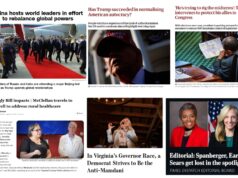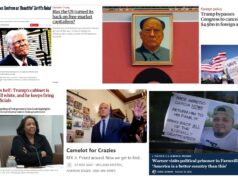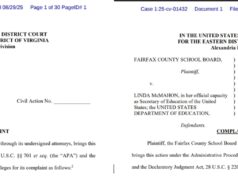A Book Report, cross posted from Vox Fairfax
By Barbara Baum Levine, Esq.
 I highly recommend that all Americans read the Mueller report. Yes, it is a bit of a slog. No, you don’t have to read every Court citation where Mueller is setting forth the brilliant argument for obstruction of justice by refuting every possible defense that could be presented. But the report in its entirety so clearly sets forth the actions of the President and his inner circle as well as the illegalities these actions represent, that it truly behooves all citizens to read and understand what went on.
I highly recommend that all Americans read the Mueller report. Yes, it is a bit of a slog. No, you don’t have to read every Court citation where Mueller is setting forth the brilliant argument for obstruction of justice by refuting every possible defense that could be presented. But the report in its entirety so clearly sets forth the actions of the President and his inner circle as well as the illegalities these actions represent, that it truly behooves all citizens to read and understand what went on.
Part I reads more like the Russian novel you tried to read in high school but couldn’t keep track of all the Russian names. Part II is closer to your favorite crime novel or perhaps Mario Puzo’s The Godfather. Taken together, it is a remarkable representation of the work performed by Mueller and his team.
PART I
My impression of Part I is as follows: Mueller took his charge seriously and primarily looked at the Russian operatives who were endeavoring to meet with the Trump campaign and undermine our American election system. He took great pride in indicting a number of Russians involved in this plan, but seemed to shy away from delving too far into the Trump inner circle (primarily Trump, Trump Jr., Kushner, etc.) For example, he found that Jeff Sessions had pretty much committed perjury in his testimony, not only before Congress, but also in meetings with the Mueller team. Nevertheless, Mueller went to great lengths to try to explain Sessions’ actions and to excuse him from prosecution. My sense is that Mueller was really bending over backwards not to indict members of the President’s “team,” perhaps as part of the overall interdiction against indicting a sitting President set forth by the Justice Department. He did, of course, bring a number of actors to justice–Flynn, Manafort, and Cohen, because not only had they committed perjury, but Mueller was actually able to present corroborating and/or hard evidence of that fact.
However, and I believe despite Mueller’s best efforts to cast the President and his closest cadre in the best light, all he can ultimately say is that a criminal case for conspiracy could not be made. Why? Because he clearly states in the report that he knows that the people questioned either lied to him, or at best were part of a mass epidemic of amnesia. He also knows, and states quite directly, that emails were erased and documents disappeared.
“Accordingly, while this report embodies factual and legal determinations that the Office believes to be accurate and complete to the greatest extent possible, given these identified gaps, the Office cannot rule out the possibility that the unavailable information would shed additional light on (or cast in a new light) events described in this report.” –Executive Summary to Volume I.
PART II
Part II, in my opinion, is a clear and direct road map for impeachment. In three very concise and specific sections it offers all of the elements necessary for a finding of Obstruction of Justice.
Section I sets forth Background Legal and Evidentiary Principles, laying out the basic elements of obstruction: definition of the obstructive act; nexus (connection) to a pending or contemplated official proceeding; and, what can best be described as the individual’s mindset and actions (has the individual acted “corruptly”, in a way that would obtain an improper advantage?).
Soon after he fired Comey, however, the President became aware that investigators were conducting an obstruction-of-justice inquiry into his own conduct. That awareness marked a significant change in the President’s conduct and the start of a second phase of action.
Section II presents the factual results of the Obstructive Investigation, much of which has been thoroughly reported by print and cable news, such as statements and interchanges between the President and James Comey, Don McGahn, Lt. Gen. Flynn, and so forth. Mueller reports a noted difference in the President after he fired Comey and became aware that he was, indeed, a target of the obstruction of justice investigation:
“Soon after he fired Comey, however, the President became aware that investigators were conducting an obstruction-of-justice inquiry into his own conduct. That awareness marked a significant change in the President’s conduct and the start of a second phase of action. The President launched public attacks on the investigation and individuals involved in it who could possess evidence adverse to the President, while in private, the President engaged in a series of targeted efforts to control the investigation.” –Factual Results of the Obstruction Investigation.
. . . [but] for the Justice Department’s internal memo advising against indictment of a sitting President, Mueller would have absolutely indicted the President.
Section III most importantly takes an extensive look at potential defenses the President’s legal team could raise against a charge of obstruction of justice and refutes each and every one, citing law and legal precedent. It is quite evident that, but for the Justice Department’s internal memo advising against indictment of a sitting President, Mueller would have absolutely indicted the President. Instead, the best he could do was to lay out the entire legal brief, setting forth the elements of obstruction and the evidence that such had occurred and replete with supporting case law, not only for the case at hand, but in refutation of any and all defenses that could possibly be raised.
Given Mueller’s conservative approach and determination not to proceed against any individual unless a fairly airtight case could be made, his now famous comment–if we had confidence after a thorough investigation of the facts that the President clearly did not commit obstruction of justice, we would so state–speaks volumes. Whether we agree or not about the absolute effect of a 1973 Department of Justice memo, Mueller considered it to be absolute. Thus, he did the next best thing, the only thing he could do under the circumstances: He created an airtight case for Congress to pursue, citing elements, factual findings, and supporting case law, all wrapped up in a neat package with a big red bow.
Do we insist that Congress bring a President of the United States to justice or do we just wait to see what the next election cycle brings?
It becomes up to us to decide. Do we insist that Congress bring a President of the United States to justice or do we just wait to see what the next election cycle brings? Either way, we need to truly assess how our decisions will affect the future of our laws and our democracy.














![Video: VA11 Dem Nominee James Walkinshaw Says “I’m excited to vote in November as well, but we’ve [also] got to be excited to vote on September 9th”](https://bluevirginia.us/wp-content/uploads/2025/08/walknshawwhite-100x75.jpg)